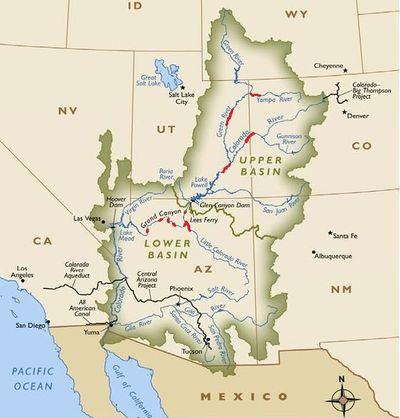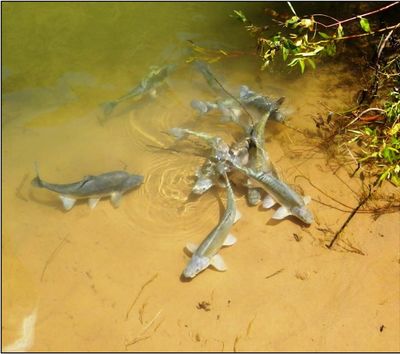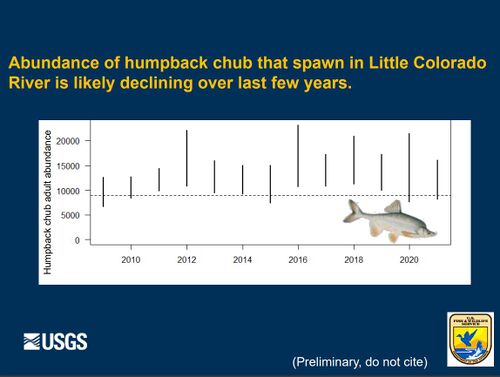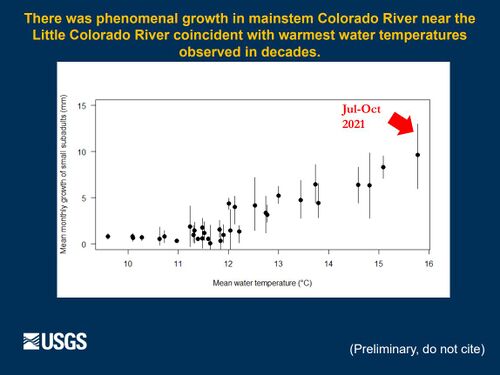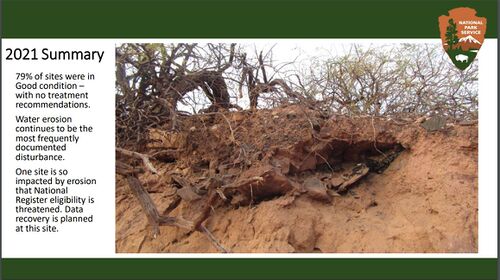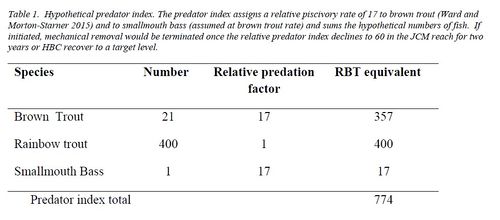Difference between revisions of "Humpback Chub Page"
Cellsworth (Talk | contribs) |
Cellsworth (Talk | contribs) |
||
| (13 intermediate revisions by the same user not shown) | |||
| Line 70: | Line 70: | ||
! <h2 style="margin:0; background:#cedff2; font-size:120%; font-weight:bold; border:1px solid #a3bfb1; text-align:left; color:#000; padding:0.2em 0.4em;">Updates</h2> | ! <h2 style="margin:0; background:#cedff2; font-size:120%; font-weight:bold; border:1px solid #a3bfb1; text-align:left; color:#000; padding:0.2em 0.4em;">Updates</h2> | ||
| − | [[File: | + | [[File:2021 HBC Abundance.JPG|center|500px]] [https://www.usbr.gov/uc/progact/amp/amwg/2022-02-10-amwg-meeting/20220210-FisheriesReview-AnnualReportingFY2021-508-UCRO.pdf https://www.usbr.gov/uc/progact/amp/amwg/2022-02-10-amwg-meeting/20220210-FisheriesReview-AnnualReportingFY2021-508-UCRO.pdf] |
| − | [[File: | + | [[File:2021 HBC Growth.JPG|center|500px]] [https://www.usbr.gov/uc/progact/amp/amwg/2022-02-10-amwg-meeting/20220210-FisheriesReview-AnnualReportingFY2021-508-UCRO.pdf https://www.usbr.gov/uc/progact/amp/amwg/2022-02-10-amwg-meeting/20220210-FisheriesReview-AnnualReportingFY2021-508-UCRO.pdf] |
| − | [[File: | + | [[File:2021 Summary.JPG|center|500px]] [https://www.usbr.gov/uc/progact/amp/amwg/2022-02-10-amwg-meeting/20220210-FisheriesReview-AnnualReportingFY2021-508-UCRO.pdf https://www.usbr.gov/uc/progact/amp/amwg/2022-02-10-amwg-meeting/20220210-FisheriesReview-AnnualReportingFY2021-508-UCRO.pdf] |
| − | + | ||
| − | [ | + | |
| − | + | ||
| − | + | ||
| − | + | ||
| − | + | ||
| − | + | ||
| − | + | ||
| − | + | ||
| − | + | ||
| − | + | ||
| − | + | ||
| − | + | ||
| − | + | ||
|- | |- | ||
| Line 109: | Line 95: | ||
*To review the SSA visit: [https://www.fws.gov/mountain-prairie/pressrel/2018/HumpbackChub_SSA_Final_26Mar2018_wAppendixB&C.pdf '''Species Status Assessment for the Humpback Chub'''] | *To review the SSA visit: [https://www.fws.gov/mountain-prairie/pressrel/2018/HumpbackChub_SSA_Final_26Mar2018_wAppendixB&C.pdf '''Species Status Assessment for the Humpback Chub'''] | ||
*To review the 5-year review please visit: [https://www.fws.gov/mountain-prairie/pressrel/2018/Humpback%20Chub%205-yr%20Final%20-%20signed%203-19-18%20Compliant.pdf '''5-Year Review of the Humpback Chub'''] | *To review the 5-year review please visit: [https://www.fws.gov/mountain-prairie/pressrel/2018/Humpback%20Chub%205-yr%20Final%20-%20signed%203-19-18%20Compliant.pdf '''5-Year Review of the Humpback Chub'''] | ||
| + | |||
| + | |- | ||
| + | ! <h2 style="margin:0; background:#cedff2; font-size:120%; font-weight:bold; border:1px solid #a3b0bf; text-align:left; color:#000; padding:0.2em 0.4em;"> [http://gcdamp.com/index.php?title=Long-term_Experimental_and_Management_Plan_(LTEMP) LTEMP BiOp Conservation Measures for Humpback Chub Conservation (2016)] </h2> | ||
| + | |- | ||
| + | |style="color:#000;"| | ||
| + | |||
| + | Ongoing actions: | ||
| + | |||
| + | Reclamation would continue to support the NPS, FWS, GCMRC, and GCDAMP in funding and implementing '''translocations''' of humpback chub into tributaries of the Colorado River in Marble and Grand Canyons, and in monitoring the results of these translocations, consistent with agencies’ plans and guidance (e.g., NPS Comprehensive Fisheries Management Plan [CFMP], FWS Humpback Chub Genetics Management Plan and Translocation Framework, and GCMRC Triennial Work Plan). Translocations allow for opportunities to expand the area occupied by humpback chub and improve the overall status of the species. Specifically, the following would occur: | ||
| + | |||
| + | *Humpback chub would be translocated from the lower reaches of the Little Colorado River to areas above Chute Falls in an effort to increase growth rates and survivorship. | ||
| + | |||
| + | *Monitoring would be conducted annually, or as needed, depending on the data required, to determine survivability, population status, or genetic integrity of the Havasu Creek humpback chub population. Intermittent translocations of additional humpback chub in Havasu Creek would be conducted if the FWS and NPS determine it is necessary to maintain genetic integrity of the population. | ||
| + | |||
| + | Reclamation would continue to fund a '''spring and fall population estimate''' annually, or at a different frequency as deemed appropriate in consultation with FWS, using a mark recapture based model for the Little Colorado River or the most appropriate model developed for the current collecting techniques and data. Monitoring the chub population allows us to determine its status (whether it is stable, increasing, or decreasing). | ||
| + | |||
| + | Reclamation would continue to fund '''control or removal of nonnative fish''' in tributaries prior to chub translocations depending on the existing fish community in each tributary. Reclamation, NPS, and FWS would lead any investigation into the possibility of using a chemical piscicide, or other tools, as appropriate. Tributaries and the appropriate control methods would be identified by the FWS, NPS, Reclamation, and GCMRC, in consultation with the Arizona Game and Fish Department (AGFD). Depending on the removal methods identified, additional planning and compliance may be necessary. Removal of nonnative fishes improves the status of chub and other native fishes by reducing competition and predation. The regulation and control of nonnative fish is a management action identified in the Humpback Chub Recovery Goals (USFWS 2002a) and Razorback Sucker Recovery Goals (USFWS 2002b). | ||
| + | |||
| + | Reclamation would continue to fund the FWS in maintenance of a '''humpback chub refuge''' | ||
| + | population at a federal hatchery (Reclamation has assisted the FWS in creating a | ||
| + | humpback chub refuge at the Southwestern Native Aquatic Resources and Recovery | ||
| + | Center [SNARRC]) or other appropriate facility by providing funding to assist in annual | ||
| + | maintenance (including the collection of additional humpback chub from the Little | ||
| + | Colorado River for this purpose). In the unlikely event of a catastrophic loss of the | ||
| + | Grand Canyon population of humpback chub, the refuge would provide a permanent | ||
| + | source of sufficient numbers of genetically representative stock for repatriating the | ||
| + | species. | ||
| + | |||
| + | Reclamation would continue to assist the FWS, NPS and the GCDAMP to ensure that a | ||
| + | '''stable or upward trend''' of humpback chub mainstem aggregations can be achieved by: | ||
| + | |||
| + | *Continuing to conduct annual monitoring of the Little Colorado River humpback chub aggregation (e.g., juvenile chub monitoring parameters). Periodically, an open or multistate model should be run to estimate abundance of the entire Little Colorado River aggregation inclusive of mainstem fish. | ||
| + | |||
| + | *Supporting annual monitoring in the mainstem Colorado River to determine status and trends of humpback chub and continuing to investigate sampling and analytical methods to estimate abundance of chub in the mainstem. | ||
| + | |||
| + | *Conducting periodic surveys to identify additional aggregations and individual humpback chub. | ||
| + | |||
| + | *Evaluating existing aggregations and determining drivers of these aggregations, for example, recruitment, natal origins, spawning locations, and spawning habitat (e.g., consider new and innovative methods such as telemetry or the Judas-fish approach) (Kegerries et al. 2015). | ||
| + | |||
| + | *Exploring means of expanding humpback chub populations outside of the Little Colorado River Inflow aggregation. Evaluate the feasibility of mainstem augmentation of humpback chub that would include larval collection, rearing, and release into the mainstem at suitable areas outside of or within existing aggregations. | ||
| + | |||
| + | Reclamation would, through the GCDAMP, conduct '''disease and parasite monitoring''' in | ||
| + | humpback chub and other fishes in the mainstem Colorado. The GCMRC is currently | ||
| + | conducting parasite monitoring in the Little Colorado River. However, in order to better | ||
| + | understand how/if disease and parasites (primarily Asian tapeworm) are affecting chub | ||
| + | and how temperature differences may affect parasite occurrence, this work would be | ||
| + | expanded to include investigations of parasites in humpback chub (and surrogate fish if | ||
| + | necessary) in the mainstem. Ensuring adequate protection from diseases and parasites is | ||
| + | an identified management action needed in the Humpback Chub Recovery Goals | ||
| + | (USFWS 2002a) and Razorback Sucker Recovery Goals (USFWS 2002b). | ||
| + | |||
| + | New actions: | ||
| + | |||
| + | Reclamation would collaborate with the FWS, GCMRC, NPS, and the Havasupai Tribe | ||
| + | to conduct preliminary surveys and a feasibility study for '''translocation of humpback chub into Upper Havasu Creek (above Beaver Falls)'''. The implementation of surveys and | ||
| + | translocations, following the feasibility study, would be dependent on interagency | ||
| + | discussions, planning and compliance, and resulting outcomes of tribal consultation. As | ||
| + | stated above, translocations of chub into currently unoccupied habitat aid in expanding | ||
| + | the area occupied by the species. In addition, using a tributary to the Colorado River, | ||
| + | such as Upper Havasu Creek, protects translocated fish from the effects of dam | ||
| + | operations in the mainstem, but still allow for chub in Havasu Creek to contribute to the | ||
| + | mainstem population. | ||
| + | |||
| + | Reclamation would, in cooperation with the FWS, NPS, GCMRC, and AGFD, explore | ||
| + | and '''evaluate other tributaries for potential translocations'''. | ||
| + | |||
| + | |||
| + | |- | ||
| + | ! <h2 style="margin:0; background:#cedff2; font-size:120%; font-weight:bold; border:1px solid #a3b0bf; text-align:left; color:#000; padding:0.2em 0.4em;"> [[Media:Appendix D Final Chub Triggers 2017.pdf| LTEMP BiOp Triggers for Humpback Chub (LTEMP BA Appendix D)]] </h2> | ||
| + | |- | ||
| + | |style="color:#000;"| | ||
| + | |||
| + | === '''Tier 1 Trigger – Early Intervention Through Conservation Actions:''' === | ||
| + | |||
| + | *1a. If the combined point estimate for adult HBC (adults defined ≥200 mm) in the Colorado River mainstem LCR aggregation; RM 57-65.9) and Little Colorado River (LCR) falls below 9,000 as estimated by the currently accepted HBC population model (e.g., ASMR, multi-state). | ||
| + | |||
| + | -OR- | ||
| + | |||
| + | *1b. If recruitment of sub-adult HBC (150-199mm) does not equal or exceed estimated adult mortality such that: | ||
| + | |||
| + | # Sub-adult abundance falls below a three-year running average of 1,250 fish in the spring LCR population estimates, or | ||
| + | # Sub-adult abundance falls below a three-year running average of 810 fish in the mainstem Juvenile Chub Monitoring reach (JCM annual fall population estimate; RM 63.45-65.2). | ||
| + | |||
| + | ===Tier 1 Trigger Response: === | ||
| + | *Tier 1 conservation actions listed below will be immediately implemented either in the LCR or in the adjacent mainstem. Conservation actions will focus on increasing growth, survival and distribution of HBC in the LCR & LCR mainstem aggregation area. | ||
| + | |||
| + | It is expected that the conservation actions proposed below will assist in ameliorating HBC adult losses or recruitment failures from predation. First, ongoing translocations in the LCR above Chute Falls (~300 fish/year) as well as outside the LCR population (e.g., to Havasu Creek, etc.) will continue, regardless of Tier 1 triggers are met or not. New conservation actions will include expansion of existing activities coupled with experimental actions: | ||
| + | |||
| + | *LCR - Expand translocation actions in the LCR by collecting an additional 300-600 young of the year (YOY) HBC and move to above Chute Falls in October. | ||
| + | *LCR - Assess efficacy of transporting larval HBC (April/May) into Big Canyon and above Blue Springs in the LCR system. Evaluate growth and survival of these transplants; | ||
| + | *Mainstem LCR Aggregation - Larval fish will be removed from LCR (April/May) and head-started at Southwest Native Aquatic Resources and Recovery Center (SNARRC). Once fish reach 150-200 mm they will be translocated to the mainstem LCR reach the following year (currently grow-out space at SNARRC is limited to 750 HBC, use of fish for this purpose would reduce numbers available for other actions, e.g. Havasu, Shinumo.); | ||
| + | *Additional conservation actions as identified and evaluated. | ||
| + | |||
| + | === '''Tier 2 Trigger - Reduce threat using mechanical removal if conservation actions in Tier 1 are insufficient to arrest a population decline:''' === | ||
| + | Mechanical removal of nonnative aquatic predator will ensue: | ||
| + | *If the point abundance estimate of adult HBC decline to <7,000, as estimated by the currently accepted HBC population model. | ||
| + | |||
| + | Mechanical removal will terminate if: | ||
| + | *Predator index (described below) is depleted to less than 60 RBT/km for at least two years in the JCM reach (RM 60.0-64.5) and immigration rate is low (the long term feasibility of using immigration rates as a metric still needs to be assessed), | ||
| + | -OR- | ||
| + | *Adult HBC population estimates exceed 7,500 and recruitment of sub-adult chub exceed adult mortality for at least two years. | ||
| + | |||
| + | [[File:PredatorIndexTable.jpg|center|500px]] | ||
| + | |||
| + | If immigration rate of predators into JCM reach is high, mechanical removal may need to continue. These triggers are intended to be adaptive based on ongoing and future research (e.g., Lees Ferry recruitment and emigration dynamics, effects of trout suppression flows, effects of Paria River turbidity inputs on predator survival and immigration rates, interactions between humpback chub and rainbow trout, other predation studies). | ||
|} | |} | ||
| Line 122: | Line 213: | ||
|style="color:#000;"| | |style="color:#000;"| | ||
| + | *[http://gcdamp.com/index.php?title=Portal:GCDAMP_Knowlege_Assessments GCMRC Annual Reports page] | ||
*[http://www.coloradoriverrecovery.org/general-information/the-fish/humpback-chub.html Upper Colorado River Endangered Fish Recovery Program ] | *[http://www.coloradoriverrecovery.org/general-information/the-fish/humpback-chub.html Upper Colorado River Endangered Fish Recovery Program ] | ||
*[https://ecos.fws.gov/ecp0/profile/speciesProfile?spcode=E000 USFWS ECOS humpback chub site] | *[https://ecos.fws.gov/ecp0/profile/speciesProfile?spcode=E000 USFWS ECOS humpback chub site] | ||
| Line 151: | Line 243: | ||
|style="color:#000;"| | |style="color:#000;"| | ||
| + | *[https://www.usbr.gov/uc/DocLibrary/Reports/LTEMPReports/20211200-Five-yearReviewActionTriggersManagementHumpbackChub-508-UCRO.pdf 2021 Five-year Review of Action Triggers for the Management of Humpback Chub for the LTEMP BiOp] | ||
*[[Media:Chub downlisting draft 2020.pdf| 2020 Humpback chub downlisting FRN ]] | *[[Media:Chub downlisting draft 2020.pdf| 2020 Humpback chub downlisting FRN ]] | ||
*[http://www.coloradoriverrecovery.org/documents-publications/foundational-documents/recoverygoals/HumpbackChub_SSA_Final_26Mar2018_wAppendixB&C.pdf 2018 Humpback Chub Species Status Assessment] | *[http://www.coloradoriverrecovery.org/documents-publications/foundational-documents/recoverygoals/HumpbackChub_SSA_Final_26Mar2018_wAppendixB&C.pdf 2018 Humpback Chub Species Status Assessment] | ||
| Line 171: | Line 264: | ||
|- | |- | ||
|style="color:#000;"| | |style="color:#000;"| | ||
| + | |||
| + | '''2024''' | ||
| + | *[[Media:ARM_HBC_Growth_Poster_2024_V2_final.pdf| Humpback chub growth becomes resource dependent when released from temperature limitation]] | ||
| + | |||
| + | '''2023''' | ||
| + | *[https://www.usbr.gov/uc/progact/amp/twg/2023-11-08-twg-meeting/20231108-FishPropagationProgram-508-UCRO.pdf Fish Propagation Program] | ||
| + | *[https://doi.org/10.1002/tafs.10415 Dzul et al., 2023, Vital rates of a burgeoning population of humpback chub in western Grand Canyon: Transactions of the American Fisheries Society] | ||
| + | *[https://www.usbr.gov/uc/progact/amp/twg/2023-01-26-twg-meeting/20230126-AnnualReportingMeeting-MonitoringHumpbackChubLittleColoradoRiverGrand%20Canyon-508-UCRO.pdf Monitoring Humpback Chub in the Little Colorado River and Colorado River, Grand Canyon] | ||
| + | *[https://www.usbr.gov/uc/progact/amp/twg/2023-01-26-twg-meeting/20230126-AnnualReportingMeeting-GrandCanyonNationalParkFisheriesProgramUpdates-FY2022-508-UCRO.pdf Grand Canyon National Park Fisheries Program Updates, FY 2022] | ||
| + | |||
| + | '''2022''' | ||
| + | *[https://www.usbr.gov/uc/progact/amp/amwg/2022-02-10-amwg-meeting/20220210-FisheriesReview-AnnualReportingFY2021-508-UCRO.pdf Fisheries review: Annual Reporting FY2021 ] | ||
| + | *[https://www.usbr.gov/uc/progact/amp/twg/2022-01-13-twg-meeting/20220113-AnnualReportingMeeting-MonitoringHumpbackChubLittleColoradoRiverColoradoRiverGrandCanyon-508-UCRO.pdf Monitoring Humpback Chub in the Little Colorado River and Colorado River, Grand Canyon ] | ||
'''2021''' | '''2021''' | ||
| + | *[https://www.usbr.gov/uc/progact/amp/twg/2021-10-14-twg-meeting/20211014-ProjectedClimateGeomorphicChangesLittleColoradoRiver-Presentation-508-UCRO.pdf Projected Climate and Geomorphic Changes in the Little Colorado River Watershed and Potential Links to Humpback Chub Habitat] | ||
| + | *[https://www.usbr.gov/uc/progact/amp/twg/2021-10-14-twg-meeting/20211014-Update5-yearReviewManagementTriggersHumpbackChub-Presentation-508-UCRO.pdf Update on 5-year Review of Management Triggers for Humpback Chub ] | ||
| + | *[https://www.usbr.gov/uc/progact/amp/twg/2021-06-17-twg-meeting/20210617-ProposedActionTriggersManagementHumpbackChub-508-UCRO.pdf Proposed Action Triggers for the Management of Humpback Chub Colorado River, Grand Canyon ] | ||
| + | *[https://www.usbr.gov/uc/progact/amp/twg/2021-04-14-twg-meeting/20210414-LTEMPBiologicalOpinion%E2%80%93HumpbackChubTriggerReviewCurrentStatusUpdate-508-UCRO.pdf Long-Term Experimental & Management Plan Biological Opinion – Humpback Chub Trigger Review & Current Status Update ] | ||
*[https://www.usbr.gov/uc/progact/amp/amwg/2021-02-11-amwg-meeting/20210211-GCDAMPAnnualReportingMeetingUpdateFishes-508-UCRO.pdf GCDAMP Annual Reporting Meeting Update: Fishes ] | *[https://www.usbr.gov/uc/progact/amp/amwg/2021-02-11-amwg-meeting/20210211-GCDAMPAnnualReportingMeetingUpdateFishes-508-UCRO.pdf GCDAMP Annual Reporting Meeting Update: Fishes ] | ||
*[https://www.usbr.gov/uc/progact/amp/twg/2021-01-22-twg-meeting/20210122-TWGMeeting-LTEMPBiologicalOpinionConservationMeasuresUpdate-508-UCRO.pdf Long-Term Experimental and Management Plan Biological Opinion Conservation Measures Update ] | *[https://www.usbr.gov/uc/progact/amp/twg/2021-01-22-twg-meeting/20210122-TWGMeeting-LTEMPBiologicalOpinionConservationMeasuresUpdate-508-UCRO.pdf Long-Term Experimental and Management Plan Biological Opinion Conservation Measures Update ] | ||
| Line 286: | Line 396: | ||
*[https://www.usbr.gov/uc/progact/amp/amwg/2009-04-29-amwg-meeting/Attach_17.pdf News Release: Salazar and Locke Restore Scientific Consultations under the Endangered Species Act to Protect Species and their Habitats] | *[https://www.usbr.gov/uc/progact/amp/amwg/2009-04-29-amwg-meeting/Attach_17.pdf News Release: Salazar and Locke Restore Scientific Consultations under the Endangered Species Act to Protect Species and their Habitats] | ||
*[https://www.usbr.gov/uc/progact/amp/twg/2009-03-16-twg-meeting/Attach_05.pdf Grand Canyon Monitoring and Research Center updates by Program Managers] | *[https://www.usbr.gov/uc/progact/amp/twg/2009-03-16-twg-meeting/Attach_05.pdf Grand Canyon Monitoring and Research Center updates by Program Managers] | ||
| − | |||
| − | |||
| − | |||
| − | |||
| − | |||
| − | |||
| − | |||
| − | |||
| − | |||
| − | |||
| − | |||
| − | |||
| − | |||
| − | |||
| − | |||
| − | |||
| − | |||
| − | |||
| − | |||
| − | |||
| − | |||
| − | |||
| − | |||
| − | |||
| − | |||
| − | |||
| − | |||
| − | |||
| − | |||
| − | |||
| − | |||
| − | |||
| − | |||
| − | |||
| − | |||
| − | |||
| − | |||
| − | |||
| − | |||
| − | |||
| − | |||
| − | |||
| − | |||
| − | |||
| − | |||
| − | |||
| − | |||
| − | |||
| − | |||
| − | |||
| − | |||
| − | |||
| − | |||
| − | |||
| − | |||
| − | |||
| − | |||
| − | |||
| − | |||
| − | |||
| − | |||
| − | |||
| − | |||
| − | |||
| − | |||
| − | |||
| − | |||
| − | |||
| − | |||
| − | |||
| − | |||
| − | |||
| − | |||
| − | |||
| − | |||
| − | |||
| − | |||
| − | |||
| − | |||
| − | |||
| − | |||
| − | |||
| − | |||
| − | |||
| − | |||
| − | |||
| − | |||
| − | |||
| − | |||
| − | |||
| − | |||
| − | |||
| − | |||
| − | |||
| − | |||
| − | |||
| − | |||
| − | |||
| − | |||
| − | |||
| − | |||
| − | |||
| − | |||
| − | |||
|- | |- | ||
Revision as of 17:55, 5 February 2024
|
|
DescriptionThe humpback chub (Gila cypha) is an endangered, native endemic of the Colorado River that evolved around 3-5 million years ago. The pronounced hump behind its head gives this fish a striking, unusual appearance. It has an olive-colored back, silver sides, a white belly, small eyes and a long snout that overhangs its jaw. Like the Colorado pikeminnow and bonytail, the humpback chub is a member of the minnow family. The humpback chub is a relatively small fish by most standards – its maximum size is about 20 inches and 2.5 pounds. By minnow standards it is a big fish, though not like the giant of all minnows – the Colorado pikeminnow. Humpback chub can survive more than 30 years in the wild. It can spawn as young as 2 to 3 years of age during its March through July spawning season. Although the humpback chub does not have the swimming speed or strength of the Colorado pikeminnow, its body is uniquely formed to help it survive in its whitewater habitat. The hump that gives this fish its name acts as a stabilizer and a hydrodynamic foil that helps it maintain position and also probably helped it escape predation by making it difficult to be swallowed by all but the largest pikeminnow. The humpback chub uses its large fins to “glide” in eddy complexes, feeding on insects that become trapped in pockets of slow-moving water. [1] Status and distribution
The humpback chub was listed as endangered by U.S. Fish and Wildlife Service in 1967 and given full protection under the Endangered Species Act of 1973. Historically, humpback chub were probably limited to the eddy complexes of several canyon reaches of the Colorado River and three of its tributaries: the Green and Yampa rivers in Colorado and Utah, and the Little Colorado River in Arizona. The species was first described in 1946. Before that time, few people ventured into these treacherous canyons – including fishery biologists. Today, five self-sustaining populations of humpback chub occur in the Upper Colorado River Basin. Two to three thousand adults can occur in the Black Rocks and Westwater Canyon core population in the Colorado River near the Colorado/Utah border. Several hundred to more than 1,000 adults may occur in the Desolation/Gray Canyon core population in the Green River. Populations in Yampa and Cataract canyons are small, each consisting of up to a few hundred adults. The largest population of humpback chub is found in the Grand Canyon -- primarily in the Little Colorado River (LCR) and its confluence with the main stem Colorado River. In 2009, the U.S. Geological Survey announced that this population increased by about 50 percent from 2001 to 2008 to between 6,000 and 10,000 adults. [2] The 2018 5-Year Status Review concluded that the humpback chub is not in danger of extinction throughout all of its range, but is likely to become so in the foreseeable future; that is, it is a threatened species throughout all of its range. Therefore, the USFWS made a recommendation to downlist the humpback chub to threatened status. [[3] LTEMP Resource Goal for Humpback ChubMeet humpback chub recovery goals, including maintaining a self-sustaining population, spawning habitat, and aggregations in the Colorado River and its tributaries below the Glen Canyon Dam. Desired Future Condition for Humpback Chub• Achieve HBC recovery in accord with the Endangered Species Act (ESA), the HBC comprehensive management plan, and with the assistance of collaborators within and external to the AMP. |
| |
Fish of the Colorado River below Glen Canyon Dam - GCDAMP training prepared by AZFGD |
|
|---|
|
|

